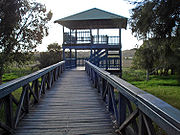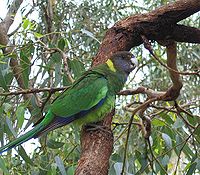
Yellagonga Regional Park
Encyclopedia

Perth, Western Australia
Perth is the capital and largest city of the Australian state of Western Australia and the fourth most populous city in Australia. The Perth metropolitan area has an estimated population of almost 1,700,000....
, in the City of Wanneroo and the City of Joondalup
City of Joondalup
The City of Joondalup is a council and Local Government Area with City status in Perth, Western Australia. It covers the metropolitan Perth city of Joondalup in its entirety, as well as the town centres of Hillarys and Warwick....
. The park was established in 1989 by the Western Australian government and protects 1400 hectares (3,459.5 acre) hectares of land, including 550 hectares (1,359.1 acre) of wetlands – Lake Joondalup
Lake Joondalup
Lake Joondalup is a medium sized lake in Perth, Western Australia. It is located in the Perth northern suburbs of Joondalup, Wanneroo, and Edgewater. It is a nature reserve and part of the Yellagonga Regional Park.-Features:...
, Beenup Swamp, Walluburnup Swamp, and Lake Goollelal.
The park contains heritage buildings, including Perry's Paddock, Cockman House and Luisini Winery, and recreation areas, such as Neil Hawkins Park. It is named after Yellagonga
Yellagonga
Yellagonga was the leader of the Whadjuk Noongar on the north side of the Swan River . Colonists saw Yellagonga as the owner of this area. However, land rights were also traced through women of the group...
, leader of the Mooro
Mooro
The Mooro were a Nyungar Indigenous clan who lived in and to the north of Perth, Western Australia, until shortly after European settlement at the Swan River Colony in 1829. Their territory stretched from the Swan River north to the Moore River beyond the northern limits of metropolitan Perth and...
people.
History of the park
Under the Perth Metropolitan Regional Scheme, much of the park's area was reserved in 1975. The park was named Yellagonga Regional Park in 1990, in honour of the regional Indigenous leader during European settlement, YellagongaYellagonga
Yellagonga was the leader of the Whadjuk Noongar on the north side of the Swan River . Colonists saw Yellagonga as the owner of this area. However, land rights were also traced through women of the group...
. For local Indigenous people, the area forms part of their Dreaming
Dreaming (spirituality)
The Dreaming is a common term within the animist creation narrative of indigenous Australians for a personal, or group, creation and for what may be understood as the "timeless time" of formative creation and perpetual creating....
. The site also has historical significance related to the development of the City of Wanneroo.
Geography and species
Yellagonga Regional Park consists of high elevation sloping dunes, separated by interdunal swalesSwale (geographical feature)
A swale is a low tract of land, especially one that is moist or marshy. The term can refer to a natural landscape feature or a human-created one...
that contain the park's lakes and wetlands. The western side of the park is quite steep, with a central plateau of up to 50 metres (164 ft) elevation. The eastern and southern parts of the park have a gentler slope towards Lake Goollelal and Walluburnup Swamp.
In 1996, the Department of Environmental Protection identified 217 species of flora, including 103 introduced species. The park has no recorded species of Declared Rare Flora but does have significant species, such as Jacksonia sericea
Jacksonia sericea
Jacksonia sericea, commonly known as Waldjumi, is a species of low-spreading shrub or small tree that occurs in the south west of Western Australia. Found on the Swan Coastal Plain, it grows to 0.6m, has orange flowers from December to February and grows in calcareous and sandy soils...
, Conostylis bracteata, Hibbertia cuneiformis
Hibbertia cuneiformis
Hibbertia cuneiformis, commonly known as Cut-leaf Hibbertia, is a shrub species that is endemic to the south-west of Western Australia...
, Amyema miquelii
Amyema miquelii
Amyema miquelli is a species of flowering plant, an epiphytic hemiparasitic plant of the family Loranthaceae, found attached to several species of Australian eucalypt...
, Lechenaultia linarioides
Lechenaultia linarioides
Lechenaultia linarioides, commonly named Yellow Leschenaultia, is a shrub found in Southwest Australia.-Description:A sprawling to prostrate shrub up to 1.5 metres high. Branches can reach a length of 1 metre. Branchlets arch upwardly and are covered in scattered leaves, this gives a sometimes...
and Ricinocarpus glaucus.

Australasian Bittern
The Australasian Bittern , also known as the Brown Bittern, is found in south-western and south-eastern Australia, Tasmania, New Zealand, New Caledonia and Ouvea. Populations in Australia and New Zealand have declined in the 20th century.It is a large bittern, patterned and streaked brown, buff...
and Peregrine Falcon
Peregrine Falcon
The Peregrine Falcon , also known as the Peregrine, and historically as the Duck Hawk in North America, is a widespread bird of prey in the family Falconidae. A large, crow-sized falcon, it has a blue-gray back, barred white underparts, and a black head and "moustache"...
) are protected under the Wildlife Conservation Act 1950
Wildlife Conservation Act 1950
The Wildlife Conservation Act 1950 is an act of the Western Australian Parliament that provides the statute relating to conservation and legal protection of flora and fauna....
.
The impact of humans on Yellagonga National Park is extensive in areas. Many areas were previously used for farming and these are still being rehabilitated. The grassed parkland areas have led to the invasion of natural areas by aggressive introduced grass species, and weeds are also an issue. Development of roads, utilities (such as power lines and drainage outlets) and service corridors has degraded the natural landscape. Erosion is also a problem in areas, caused by tracks and pathways created by pedestrians in unsuitable locations such as slopes.
Historical significance
The park contains three locations listed on the Western Australian Heritage RegisterHeritage Council of Western Australia
The Heritage Council of Western Australia is the Government of Western Australia agency created to identify, conserve and promote places of cultural heritage significance in the state.It was created under the Heritage of Western Australia Act...
: Perry's Paddock, Cockman House and Luisini Winery. Two native title
Native title
Native title is the Australian version of the common law doctrine of aboriginal title.Native title is "the recognition by Australian law that some Indigenous people have rights and interests to their land that come from their traditional laws and customs"...
claims have also been made on areas of the park by Indigenous Australians
Indigenous Australians
Indigenous Australians are the original inhabitants of the Australian continent and nearby islands. The Aboriginal Indigenous Australians migrated from the Indian continent around 75,000 to 100,000 years ago....
.

Western Australian Planning Commission
The Western Australian Planning Commission is a statutory authority of the Government of Western Australia that exists to coordinate planning for future land use and transport needs. It describes itself as Western Australia's "peak representative body of land use planning and development"...
and it is part of the City of Wanneroo. Perry's Paddock is notable because it is the location of Wanneroo
Wanneroo
Wanneroo may refer to:* City of Wanneroo - a local government area in the north of Perth, Western Australia* Wanneroo - a suburb in that local government area* Wanneroo Road - an arterial road north of Perth...
's first land grant, surveyed in 1838, and Picnic Race
Picnic horse racing
Picnic horse racing, or more usually picnic races or more colloquially "the picnics" refer to amateur Thoroughbred horse racing meetings, predominantly in Australia. The meetings are organized by amateur clubs, the jockeys are amateur riders, or sometimes former professional jockeys...
Days were held at the site in the 1920s. Perry's Cottage was built around 1850 and is an example of a building based on an English design adapted to local conditions.
The paddock also contains the original Wanneroo Primary School building, which was moved to the site by the City of Wanneroo in 1992 as part of a planned historical village that did not go ahead. In 2007 the City of Wanneroo approved moving the school building to Neville Park at a cost of approximately $250,000, after concerns about bushfires at Yellagonga Regional Park. The move should be completed in 2009.
Cockman House is a house built for settler James Cockman around 1870, and it is the oldest residence in Wanneroo. Luisini Winery, located on Lakeway Drive in Kingsley, was built in 1929.
There are two heritage trails within Yellagonga Regional Park, the Lake Joondalup Trail and the Yaberoo-Budjara Heritage Trail. The Lake Joondalup Trail explores the development of Wanneroo, and the Yaberoo-Budjara Trail between Lake Joondalup and Yanchep National Park
Yanchep National Park
Yanchep is a national park in Western Australia , north of Perth. The park is noted for its caves, native bush and koala colonies. It also offers cultural educational programmes offered in partnership with the local Nyoongar aboriginal people....
explores areas of significance to Indigenous Australians and European settlement.
Development
There have been ongoing proposals for developments in Yellagonga Regional Park. The City of Joondalup and the City of Wanneroo commissioned a feasibility study for an environment centre at the park in 2007. The study recommended the environment centre's placement at Lot 1 Lakeside Drive, Joondalup or Scenic Drive, Wanneroo. The City of Joondalup called for additional consultation and studies in March 2008, particularly on the financing the construction and running of the environment centre and its education programs.The National Trust
National Trust of Australia
The Australian Council of National Trusts is the peak body for community-based, non-government organisations committed to promoting and conserving Australia's indigenous, natural and historic heritage....
has proposed redeveloping Luisini Winery to create a museum of early winemaking and wine appreciation. Their proposal, which also includes a restaurant, environment centre and car park, was approved by the City of Joondalup on 27 March 2007.
The park was allocated funds by the Department of Environment and Conservation in September 2008 to build roads, a shelter, and bicycle and pedestrian paths.
External links
- Yellagonga Regional Park Department of Environment and Conservation

